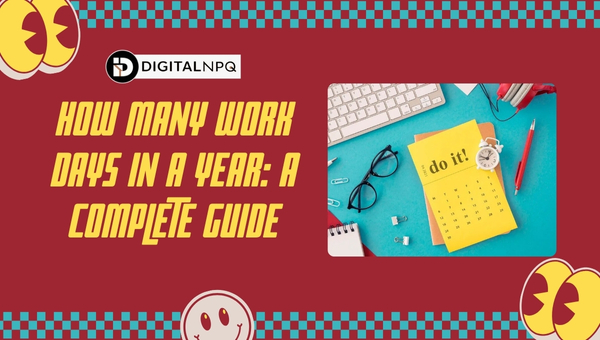How Many Work Days in a Year: A Complete Guide

Understanding how many work days in a year is essential for effective planning and productivity. This article will delve into the factors that determine the number of working days in a year, from public holidays to leap years.
We’ll also guide you on setting yearly goals, incorporating paid time off, and balancing work with your personal life. Whether you’re an employee or an employer, this comprehensive guide will equip you with the knowledge to navigate your work year efficiently.
Let’s dive in and make your work year as productive as possible!
How Many Work Days in a Year?
Determining the number of work days in a year is essential for planning and productivity. Various factors like public holidays, weekends, and work schedules can impact this count.

Let’s break down these components to understand how they affect the total work days.
Understanding the Work Week
A typical work week usually consists of five days, from Monday to Friday. Each of these days generally involves an eight-hour work shift.
Here’s a quick breakdown:
- Monday to Friday: Standard workdays
- Saturday and Sunday: Usually considered weekends
This structure forms the basis for calculating the total number of work days in a year.
Accounting for Public Holidays
Public holidays play a significant role in reducing the number of work days. These holidays vary depending on the country, state, or even company policies.
For example:
- Federal and State Holidays: These are official holidays recognized by the government.
- Company-Specific Holidays: Additional holidays provided by employers, such as company anniversaries.
It’s important to account for these holidays when calculating the total number of work days, as they can significantly reduce the annual count.
Considering Weekends
Weekends are another crucial factor in determining the number of work days in a year.
Typically, there are 52 weeks in a year, which translates to:
- 104 Weekend Days: (52 weeks x 2 days per weekend)
Given that weekends are not usually considered work days, they further reduce the total number of annual work days. For example, if we start with 365 days in a year and subtract the weekends, we’re left with:
- 365 Days – 104 Weekend Days = 261 Potential Work Days
This calculation provides a baseline, but remember, public holidays and other factors will further adjust this number.
By understanding the typical work week, accounting for public holidays, and considering weekends, you can more accurately determine the number of work days in a year.
Calculating the Number of Work Days
Determining the number of work days in a year is essential for planning and productivity. This involves considering various factors, including the standard work week, different work schedules, and even leap years. Let’s delve into these aspects to gain a comprehensive understanding.

Using a Standard 5-Day WorkWeek
In a typical 5-day work week, employees work from Monday to Friday. Here’s how you can calculate the number of work days:
- Total Days in a Year: 365 days (or 366 in a leap year)
- Weekends: 52 weeks * 2 days (Saturday and Sunday) = 104 days
- Work Days: 365 days – 104 weekend days = 261 workdays
This straightforward calculation gives us an estimate of 261 work days in a standard year. However, this number can vary based on holidays and other factors.
Different Work Schedules and Rotations
Not everyone follows a 5-day work week. Some industries and job roles have different schedules that can affect the total number of work days. Let’s consider a few examples:
- 4-Day Work Week: Some companies offer a condensed work week where employees work four days but with longer hours each day. In this case:
- Total Work Days: 52 weeks * 4 days = 208 workdays
- Rotating Shifts: In industries like healthcare or manufacturing, employees might work in rotating shifts that include weekends. For example:
- 7-On, 7-Off Schedule: Employees work 7 consecutive days followed by 7 days off. Over a year:
- Work Days: (52 weeks / 2) * 7 days = 182 workdays
- 7-On, 7-Off Schedule: Employees work 7 consecutive days followed by 7 days off. Over a year:
These variations show how different work schedules can significantly impact the number of work days in a year.
Impact of Leap Years
Leap years, which occur every four years, add an extra day to the calendar. This additional day can influence the number of work days. Here’s how:
- Standard 5-Day Work Week in a Leap Year:
- Total Days: 366 days
- Weekends: 52 weeks * 2 days + 1 extra day (Sunday) = 105 days
- Work Days: 366 days – 105 weekend days = 261 workdays
- 4-Day Work Week in a Leap Year:
- Total Work Days: 52 weeks * 4 days + 1 extra day (working) = 209 workdays
- 7-On, 7-Off Schedule in a Leap Year:
- Work Days: (52 weeks / 2) * 7 days + 1 extra working day = 183 workdays
By considering these factors, you can accurately calculate the number of work days in any given year, whether it’s a standard year or a leap year. Understanding these nuances helps in better planning and managing your work schedule effectively.
Planning Your Work Year

Planning your work year is essential for maximizing productivity and maintaining a healthy work-life balance. By setting clear goals, incorporating paid time off, and balancing professional and personal responsibilities, you can ensure a successful and fulfilling year.
Setting Goals and Objectives
Setting goals and objectives at the beginning of the year is crucial for guiding your efforts and measuring success.
Here’s how to approach it:
- Identify Your Priorities: Determine what matters most to you in your career. This could include professional development, project completion, or achieving specific milestones.
- Set SMART Goals: SMART goals are Specific, Measurable, Achievable, Relevant, and Time-bound. For example, instead of saying “I want to improve my skills,” you could set a goal to “complete an online course in project management by June.”
- Break Down Goals: Divide larger goals into smaller, manageable tasks. This makes it easier to track progress and stay motivated.
- Review and Adjust: Regularly review your goals to assess progress and make adjustments as needed. Flexibility is key to staying on track.
Incorporating Paid Time Off (PTO)
Planning for PTO is vital to ensure you take the necessary breaks without disrupting your workflow.
Here’s how to effectively incorporate PTO into your yearly schedule:
- Understand Company Policies: Familiarize yourself with your company’s PTO policies, including how much time you have and any restrictions on when it can be taken.
- Plan Ahead: Schedule your PTO well in advance, especially for longer vacations. This helps you coordinate with your team and minimize disruptions.
- Balance Workload: Ensure that your workload is manageable before and after your PTO. Delegate tasks if necessary to maintain productivity.
- Use PTO Wisely: Spread your PTO throughout the year to avoid burnout. Taking short breaks periodically can be more refreshing than a single long vacation.
Balancing Work and Personal Life
Balancing work and personal life is essential for overall well-being. Here are some strategies to achieve this balance:
- Set Boundaries: Clearly define your work hours and stick to them. Avoid working late or during weekends unless absolutely necessary.
- Prioritize Health: Make time for physical activities, proper nutrition, and adequate sleep. A healthy body supports a productive mind.
- Spend Quality Time with Loved Ones: Allocate time for family and friends. Strong personal relationships contribute to emotional well-being.
- Pursue Hobbies: Engage in activities that bring you joy and relaxation. Hobbies can provide a much-needed break from work-related stress.
- Evaluate Regularly: Periodically assess your work-life balance. Make adjustments as needed to ensure both professional success and personal happiness.
Planning your work year with clear goals, strategic use of PTO, and a balanced approach to work and personal life can lead to a more productive and satisfying year.
Factors That Affect Work Days
Understanding the factors that impact the number of work days in a year is vital for planning and efficiency.
Let’s explore how holidays, vacations, sick days, and company-specific policies play a role.
Federal and State Holidays
Federal and state holidays can significantly affect the total number of work days.
These holidays vary by region and can lead to different numbers of working days depending on where you live.
- Federal Holidays: These are national holidays recognized across the country. Examples include Independence Day, Thanksgiving, and Christmas.
- State Holidays: Each state may observe additional holidays. For instance, Texas celebrates Texas Independence Day, which is not a federal holiday.
- Impact: The total number of federal and state holidays can reduce the number of working days in a year.
Vacation and Sick Days
Vacation and sick days are another crucial factor. These days allow employees to take time off for personal reasons or health issues without affecting their overall employment status.
- Vacation Days: Many companies offer a certain number of paid vacation days. This can range from a few days to several weeks per year.
- Sick Days: Employees are also often allowed sick days to recover from illness. The number of sick days can vary widely between employers.
- Other Absences: Other types of leaves, like maternity or paternity leave, can also impact the number of work days.
Company-Specific Policies
Company-specific policies can further influence the number of work days.
Each company has its own set of rules and benefits that can affect how many days employees work each year.
- Flexible Work Schedules: Some companies may offer flexible work schedules or remote work options.
- Additional Paid Leave: Certain companies might provide extra paid leave for various reasons, such as sabbaticals or personal development.
- Unpaid Leave: Policies regarding unpaid leave can also vary, affecting the overall number of paid work days.
Understanding these factors helps in planning your work year effectively.
Importance of Knowing Work Days
Understanding how many work days there are in a year can greatly impact various aspects of your professional and personal life.
From budgeting to managing your workload, knowing this information helps you plan more effectively.
Let’s delve into why this knowledge is crucial.
Budgeting and Financial Planning
Knowing the exact number of work days in a year is essential for effective budgeting and financial planning. It helps you forecast your income and manage your expenses accordingly.
Here are some key points to consider:
- Monthly Salary Calculation: Knowing the number of work days allows you to accurately calculate your monthly salary, especially if you are paid on a daily basis.
- Expense Management: With a clear understanding of your income, you can better manage your monthly and annual expenses.
- Savings Goals: Accurate knowledge of your work days helps in setting realistic savings goals and achieving financial stability.
Managing Workload and Deadlines
Accurate knowledge of the number of work days helps in managing your workload and meeting deadlines effectively.
Here’s how:
- Task Allocation: Knowing how many days you have to complete tasks allows for better allocation of work throughout the year.
- Project Planning: It aids in planning long-term projects by breaking them down into manageable chunks.
- Stress Reduction: Effective workload management reduces stress, leading to better job performance and satisfaction.
Evaluating Job Expectations
Understanding the expected number of annual working days is crucial for evaluating job expectations and planning your work year.
Here’s why this is important:
- Performance Metrics: Knowing the number of work days helps set realistic performance metrics and goals.
- Work-Life Balance: It aids in balancing professional responsibilities with personal life by allowing for better planning of vacations and personal time.
- Job Offers: When considering job offers, understanding the expected number of working days can help you make informed decisions about workload and compensation.
By understanding how many work days there are in a year, you can better manage your finances, workload, and job expectations, leading to a more organized and fulfilling professional life.
FAQs
How do you calculate working days in a year?
To calculate working days in a year, start with the total number of days in the year (365 or 366 for leap years), subtract weekends, and then subtract public holidays.
How many days do we actually work in a year?
Typically, if you follow a standard 5-day work week, you will work around 260 days in a year. This number can be less if public holidays and personal leave days are considered.
How many full working days in a year?
Assuming a standard 5-day work week and accounting for public holidays, the number of full working days in a year is generally around 250 days. This can vary based on specific holidays and company policies.
Conclusion
Understanding how many work days are in a year is essential for effective planning and time management. By considering factors like public holidays, weekends, and various work schedules, you can accurately calculate your annual work days.
This knowledge helps in setting realistic goals, managing workloads, and balancing personal life with professional responsibilities. It’s crucial to be aware of these details to make informed decisions that impact your career and personal well-being.
If you found this article helpful, explore more of our blogs for insightful tips and guides on optimizing your work-life balance and productivity!
